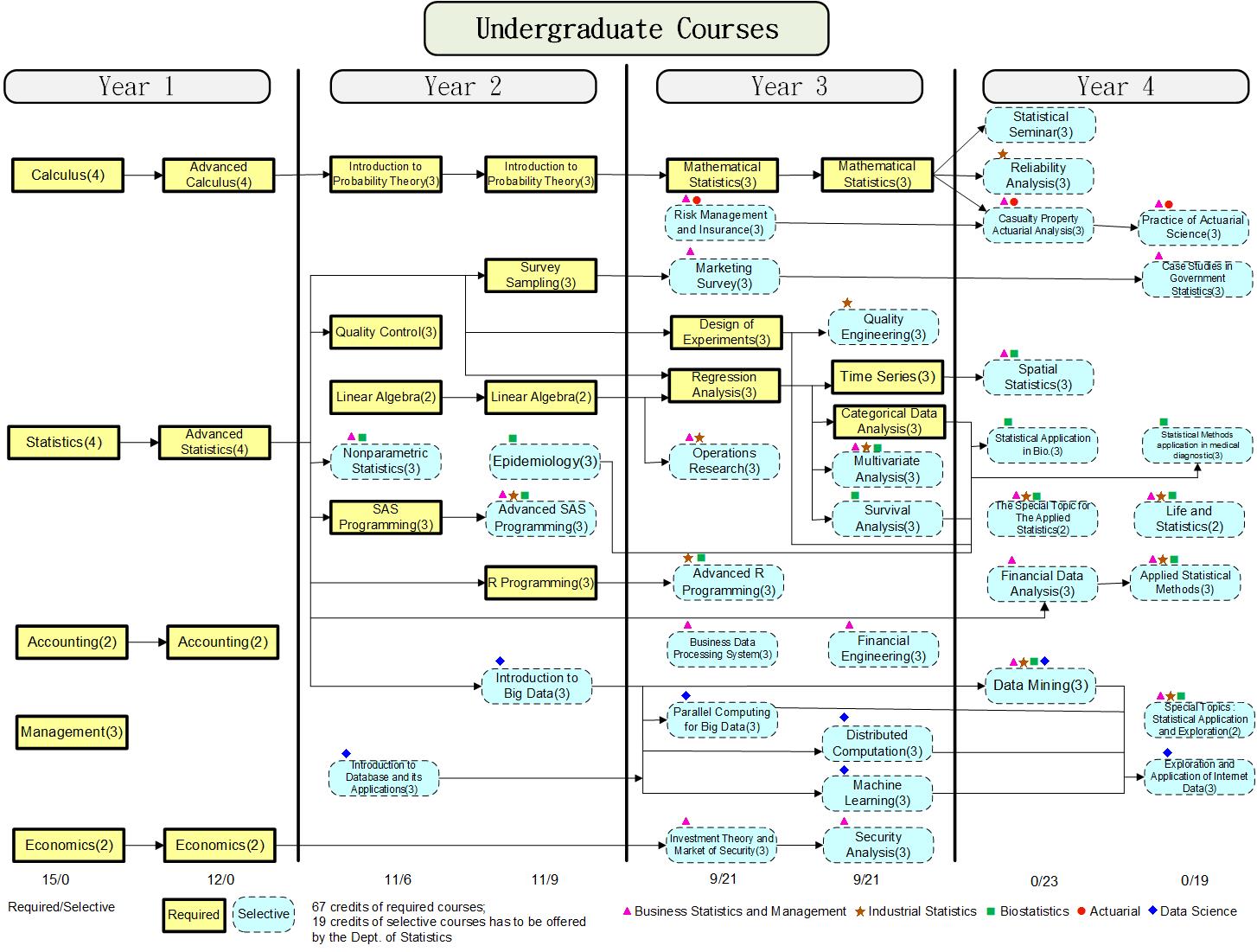Degree Requirement
To earn a Bachelor of Science (B.S.) degree in Statistics, students must complete a total of 128 credits. This includes 93 credits of required courses, 19 credits of departmental electives from the Department of Statistics, and 16 credits of electives from other departments.
Required Course List
Details of the required courses are provided below.
|
Required Courese for B.S. degree in Statistics (enrollment in 2020) |
||||||||||
|
Course Title |
Credit |
1styear |
2ndyear |
3rdyear |
4thyear |
Remarks |
||||
|
F |
S |
F |
S |
F |
S |
F |
S |
|||
|
Fundamental Courses: 12 credits |
||||||||||
|
Foreign Language (Q) |
8 |
2 |
2 |
2 |
2 |
Four credits for English and four credits for other foreign languages |
||||
|
Ability of Expressing in Spoken and Written Chinese |
2 |
|||||||||
|
Learning in University |
1 |
1 |
Learning and Development (N) |
|||||||
|
Learning and Practice of Clubs: An introduction |
1 |
1 |
||||||||
|
General Education and Core Courses: 14 credits (6 credits as required, 8 credits as selective) |
||||||||||
|
Appreciation of Chinese Literature (L) |
2 |
Humanities Field: 2 Credits required (1 out of 4 categories) |
||||||||
|
History Studies (P) |
2 |
|||||||||
|
Philosophy and Religion (V) |
2 |
|||||||||
|
Arts Appreciation and Invention (M) |
2 |
|||||||||
|
Global Outlook (T) |
2 |
Social Field: 2 Credits required (1 out of 4 categories) |
||||||||
|
Futures Studies (R) |
2 |
|||||||||
|
Social Analysis (W) |
2 |
|||||||||
|
Civil Society and Participation (S) |
2 |
|||||||||
|
Information Education (O) |
2 |
Scientific Field: 2 Credits required (1 out of 3 categories) |
||||||||
|
Global Technology Revolution (Z) |
2 |
|||||||||
|
Natural Sciences (U) |
2 |
|||||||||
|
Other |
||||||||||
|
Physical Education |
0 |
0 |
0 |
0 |
0 |
|||||
|
All-Out Defense Education Military Training(I), Nursing(I) |
0 |
0 |
0 |
|||||||
|
Campus and Community Service-Learning |
0 |
0 |
0 |
|||||||
|
Professional Courses: 67 credits |
||||||||||
|
Introduction to Computers |
4 |
2 |
2 |
Two credits of Information Education can be waived. |
||||||
|
Statistics |
4 |
4 |
||||||||
|
Advanced Statistics |
4 |
4 |
||||||||
|
Calculus |
4 |
4 |
||||||||
|
Advanced Calculus |
4 |
4 |
||||||||
|
Economics |
4 |
2 |
2 |
|||||||
|
Accounting |
4 |
2 |
2 |
|||||||
|
Management |
3 |
3 |
||||||||
|
Introduction to Probability Theory |
6 |
3 |
3 |
|||||||
|
Linear Algebra |
4 |
2 |
2 |
|||||||
|
SAS Programming |
3 |
3 |
||||||||
|
R Programming |
3 |
3 |
||||||||
|
Quality Control |
3 |
3 |
||||||||
|
Survey Sampling |
3 |
3 |
||||||||
|
Mathematical Statistics |
6 |
3 |
3 |
|||||||
|
Regression Analysis |
3 |
3 |
||||||||
|
Time Series |
3 |
3 |
||||||||
|
Design of Experiments |
3 |
3 |
||||||||
|
Categorical Data Analysis |
3 |
3 |
||||||||
Courses Tree
The diagram shows how the undergraduate courses are organized. An arrow from course A to course B means that usually course A should be taken before course B. For example, it is common to take Statistics and then follow it up with Advanced Statistics, or to take Regression Analysis and then follow it up with Time Series, Categorical Data Analysis, Multivariate Analysis and Survival Analysis.

